Related Research Articles

Chicago is the most populous city in the U.S. state of Illinois, and the third-most populous in the United States, following New York City and Los Angeles. With a population of 2,746,388 in the 2020 census, it is the most populous city in the Midwestern United States. Chicago, the county seat of Cook County, is the center of the Chicago metropolitan area, one of the largest in the world.

Grant Park is a large urban park 319 acres (1.29 km2) in the Loop community area of Chicago, Illinois. Located within the city's central business district, the park's features include Millennium Park, Buckingham Fountain, the Art Institute of Chicago, and the Museum Campus. Originally known as Lake Park, and dating from the city's founding, it was renamed in 1901 to honor US President Ulysses S. Grant. The park's area has been expanded several times through land reclamation, and was the focus of several disputes in the late 19th century and early 20th century over open space use. It is bordered on the north by Randolph Street, on the south by Roosevelt Road and McFetridge Drive, on the west by Michigan Avenue and on the east by Lake Michigan. The park contains performance venues, gardens, art work, sporting, and harbor facilities. It hosts public gatherings and several large annual events.

Merrill C. Meigs Field Airport was a single-runway airport in Chicago that was in operation from December 1948 until March 2003, on Northerly Island, an artificial peninsula on Lake Michigan. The airport sat adjacent to downtown Chicago, the second-largest business district in North America. Meigs Field airport was opened on December 10, 1948, and, by 1955, had become the busiest single-strip airport in the United States. The airport was a familiar sight on the downtown lakefront. The latest air traffic tower was built in 1952 and the terminal was dedicated in 1961. The airfield was named for Merrill C. Meigs.

Wilmette is a village in New Trier Township, Cook County, Illinois, United States. Bordering Lake Michigan, it is located 14 miles (23 km) north of Chicago's downtown district and had a population at the 2010 census of 27,087. In 2020, Wilmette was ranked by Niche.com as the best place to raise a family in Cook County based on a variety of factors including public schools grade, percentage of residents with a bachelors degree or higher, crime & safety grade, family amenities, walkability grade, percentage of households with children, and access to parks and other recreational activities. Wilmette is also home to Central Elementary School and Romona Elementary School, both recent recipients of the National Blue Ribbon award bestowed by the U.S. Department of Education.

Lincoln Park is a designated community area on the North Side of Chicago, Illinois. Lying to the west of Lincoln Park, Chicago's largest park, it is one of the most affluent neighborhoods in Chicago.
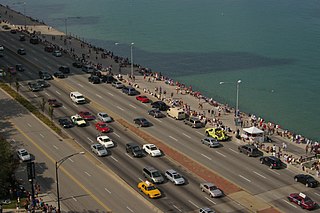
Lake Shore Drive is a multilevel expressway that runs alongside the shoreline of Lake Michigan, and adjacent to parkland and beaches, in Chicago. Except for the portion north of Foster Avenue, Lake Shore Drive is designated as part of U.S. Highway 41.

Jackson Park is a 551.5-acre (223.2 ha) park located on the South Side of Chicago, Illinois. It was originally designed in 1871 by Frederick Law Olmsted and Calvert Vaux, then greatly remodeled in 1893 to serve as the site of the World's Columbian Exposition, leaving it as one of the largest and most historically significant parks in the city. A number of features attest to the legacy of the fair, including a Japanese garden, the Statue of TheRepublic, and the Museum of Science and Industry. As part of the Woodlawn community area, it extends along Lake Michigan and borders onto the neighborhoods of Hyde Park and South Shore.

Edgewater is a lakefront community area on the North Side of the city of Chicago, Illinois six miles north of the Loop. The last of the city's 77 official community areas, Edgewater is bounded by Foster Avenue on the south, Devon Avenue on the north, Ravenswood Avenue on the west, and Lake Michigan on the east. Edgewater contains several beaches that residents enjoy during the late spring, summer, and early autumn. Chicago's largest park, Lincoln Park, stretches south from Edgewater for seven miles along the waterfront, almost to downtown. Historically, Edgewater was the northeastern corner of Lake View Township, an independent suburb annexed by the city of Chicago in 1889. Today, the Uptown community is to Edgewater's south, Lincoln Square to its west, West Ridge to its northwest and Rogers Park to its north.
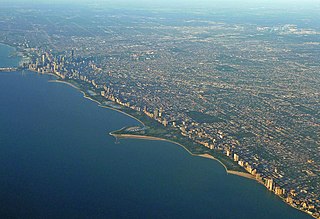
Lincoln Park is a 1,208-acre (489-hectare) park along Lake Michigan on the North Side of Chicago, Illinois. Named after US President Abraham Lincoln, it is the city's largest public park and stretches for seven miles (11 km) from Grand Avenue, on the south, to near Ardmore Avenue on the north, just north of the Lake Shore Drive terminus at Hollywood Avenue. Several museums and a zoo are located between North Avenue and Diversey Parkway in the eponymous neighborhood. Further to the north, the park is characterized by parkland, beaches, recreational areas, nature reserves, and harbors. To the south, there is a more narrow strip of beaches east of Lake Shore Drive, almost to downtown. With 20 million visitors per year, Lincoln Park is the second-most-visited city park in the United States, behind Central Park.

Uptown is one of Chicago, Illinois’ 77 community areas. Uptown's boundaries are Foster Avenue on the north; Lake Michigan on the east; Montrose, and Irving Park on the south; Ravenswood, and Clark on the west. To the north is Edgewater, to the west is Lincoln Square, and to the south is Lake View.
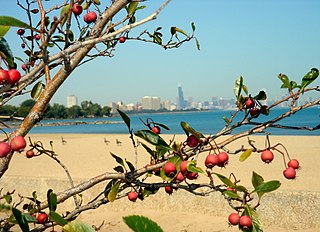
South Shore is one of 77 defined community areas of Chicago, Illinois, United States. Located on the city's South Side, the area is named for its location along the city's southern lakefront. Although South Shore has seen a greater than 40% decrease in residents since Chicago's population peaked in the 1950s, the area remains one of the most densely populated neighborhoods on the South Side. The community benefits from its location along the waterfront, its accessibility to Lake Shore Drive, and its proximity to major institutions and attractions such as the University of Chicago, the Museum of Science and Industry, and Jackson Park.

West Side Park was the name used for two different ballparks that formerly stood in Chicago, Illinois. They were both home fields of the team now known as the Chicago Cubs of the National League. Both ballparks hosted baseball championships. The latter of the two parks, where the franchise played for nearly a quarter century, was the home of the first two world champion Cubs teams, the team that posted the best winning percentage in Major League Baseball history and won the most games in National League history (1906), the only cross-town World Series in Chicago (1906), and the immortalized Tinker to Evers to Chance double-play combo. Both ballparks were primarily constructed of wood.
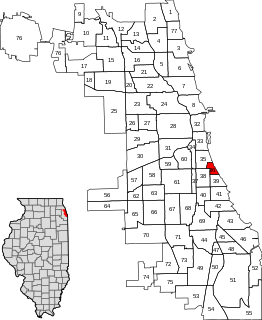
Oakland, located on the South Side of Chicago, Illinois, USA, is one of 77 officially designated Chicago community areas. Bordered by 35th and 43rd Streets, Cottage Grove Avenue and Lake Shore Drive, The Oakland area was constructed between 1872 and 1905. Some of Chicago's great old homes may be seen on Drexel Boulevard. The late 19th-century Monument Baptist Church on Oakwood Blvd. is modeled after Boston's Trinity Church. Oakwood /41st Street Beach in Burnham Park is at 4100 S. Lake Shore Drive. With an area of only 0.6 sq mi Oakland is the smallest community area by area in Chicago.

The Chicago Park District is one of the oldest and the largest park districts in the United States. As of 2016, there are over 600 parks included in the Chicago Park District as well as 27 beaches, several boat harbors, two botanic conservatories, a zoo, and 11 museums. The Chicago Park District also has more than over 230 field houses, 78 public pools, and dozens of sports and recreational facilities, with year-round programming. The district is an independent taxing authority as defined by Illinois State Statute and is considered a separate agency of the City of Chicago. The district's headquarters are located in the Time-Life Building in the Streeterville neighborhood.
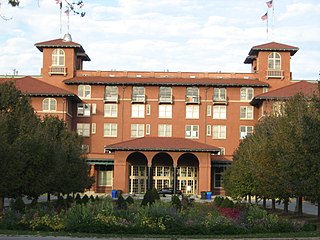
The South Shore Cultural Center, in Chicago, Illinois, is a cultural facility located at 71st Street and South Shore Drive, in the city's South Shore neighborhood. It encompasses the grounds of the former South Shore Country Club.
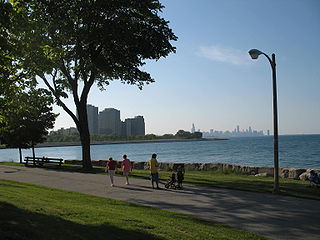
Burnham Park is a public park located in Chicago, Illinois. Situated along 6 miles (9.7 km) of Lake Michigan shoreline, the park connects Grant Park at 14th Street to Jackson Park at 56th Street. The 598 acres (242 ha) of parkland is owned and managed by Chicago Park District. It was named for urban planner and architect Daniel Burnham in 1927. Burnham was one of the designers of the 1893 World's Columbian Exposition.
The Port of Chicago consists of several major port facilities within the city of Chicago, Illinois, operated by the Illinois International Port District. It is a multimodal facility featuring Senator Dan Dougherty Harbor, the Iroquois Landing Lakefront Terminus, and Harborside International Golf Center. The central element of the Port District, Calumet Harbor, is maintained by the U.S. Army Corps of Engineers.

The Chicago Lakefront Trail (LFT) is a 18.5-mile-long (29.8 km) partial shared use path for walking, jogging, skateboarding, and cycling, located along the western shore of Lake Michigan in Chicago, Illinois. The trail passes through and connects Chicago's four major lakefront parks along with various beaches and recreational amenities. It also serves as a route for bicycle, skateboard and personal transporter commuters. On busy summer days 70,000 people use the trail.
Walter Clarence Peacock, was a Chicago businessman best known as the president of C. D. Peacock Jewelry Company, which was established by his father in 1837. Peacock was also a well known sportsman, particularly as a trap shooter; he won several national championships in this sport. He graduated from the University of Chicago.
References
- 1 2 3 4 5 Recktenwald, William (February 11, 1991). "Lakefront Gun Club Finds Itself The Target". Chicago Tribune. Retrieved 24 February 2013.
- 1 2 Recktenwald, William (February 15, 1991). "Lakefront Gun Club Must Hold Its Fire". Chicago Tribune. Retrieved 24 February 2013.
- ↑ Jouzaitis, Carol (August 12, 1991). "Gun Range Gone After 79 Years". Chicago Tribune. Retrieved 24 February 2013.
- ↑ Hevrdejs, Judy (May 23, 1995). "Gun club reopening, but it will be a shell of its former self". Chicago Tribune.
- ↑ Staff (July 7, 1993). "Metro Briefings". Chicago Sun-Times.